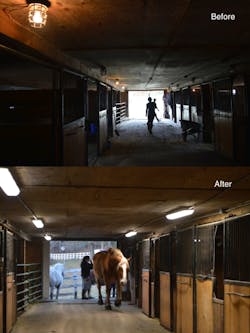The Blue Star Equiculture sanctuary for rescued horses has transitioned from incandescent, halogen, and compact-fluorescent lighting to SSL eliminating the need for regular lamp changes.
MaxLite has announced an LED lighting retrofit at the Blue Star Equiculture facility located in Palmer, MA in partnership with utility National Grid. The sanctuary for rescued draft horses had struggled with lighting in the relatively harsh environment of a barn. The solid-state lighting (SSL) retrofit has eliminated the constant need to replace lamps, and the facility has realized much improved lighting and energy savings as well.
The Blue Star project was enabled by funding via the National Grid Small Business Energy Efficiency Program. Small businesses can receive incentives under the program for 70% of the cost of qualifying energy-efficiency projects. The utility said more than 2000 small business in Massachusetts took advantage of the program last year.
"National Grid is committed to our local communities," said Michelle Eburn, senior marketing analyst at National Grid. "We place a strong emphasis on doing what we can to improve the lives of our customers and employees. Our Small Business Program helps customers like Blue Star save money on their electricity and natural gas bills, allowing them to focus more of their time and resources on providing services that benefit our communities."
Still, it was the maintenance cycle of legacy lighting, along with poor light quality, that plagued the farm. "Before the upgrade, we were lighting some of the barn with old 100W incandescent bulbs, and that was just not adequate," said Blue Star’s Paul Moshimer, who handles day-to-day operations. "We were forever changing bulbs, because they were always burning out. We tried installing some halogen lights, thinking that would improve the situation, but those were expensive and they didn't last very long, either."
MaxLite and National Grid engaged lighting consultancy Cadmus to design a new LED lighting system. Contractor Hickman & Sgroi handled the installation.
The project included the replacement of 37 75W incandescent fixtures with 28 MaxLite LED Vapor Tight linear fixtures in the stalls, storage areas, and workspaces. Eight halogen and compact-fluorescent (CFL) fixtures in the entryways were replaced with 45W LED floodlights.
The results are stunning in terms of quality and potential savings. "The barn is so much easier to see in and work in," said Moshimer. "The quality of the light is so much more even. It's been a wonderful addition to the farm."
The LED lightingproducts are rated for 50,000 hours of life. National Grid projects that the farm will use 150,000 kWh less energy over that period. The maintenance and energy savings are projected at $34,000 over the lifetime.
"Between the additional light and the savings on our electricity bills, the difference will be substantial," said Moshimer. "The quality of the light is so wonderful. Every phase of the upgrade has been a revelation."
LED-based SSL is bringing maintenance savings and better light quality to a variety of agricultural and livestock applications where conditions are relatively rugged, and delivering surprising results. For example, we recently covered a Michigan dairy that had increased milk production via SSL. Moreover, we have a feature in our archives that addresses a number of agricultural applications.






